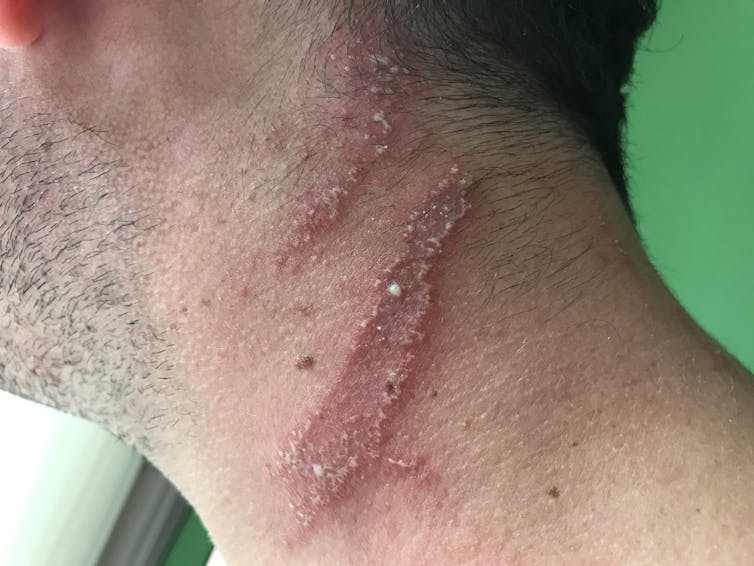A huge swarm of small black and red insects were recently seen in a town called Kabarnet, in western Kenya.
Debate has been been raging in the local media about what to call the insects: Nairobi fly, Kenya fly, narrow bee fly? There is no official name but “Nairobi fly” seems to be the most commonly used. Other parts of the world have their own local names.
In fact, the insects are neither flies, nor bees. They’re beetles. They belong to the genus Paederus which contains about 600 described species and is part of the beetle family Staphylinidae, commonly known as rove beetles.
They are well known, and feared, for the burns – or dermatitis – that they can cause on human skin.
The genus Paederus was described by the Danish entomologist Johann Christian Fabricius in 1775, though it was known to Chinese medicine over 1,200 years before this. An insect called ch’ing yao ch’ung was described in 739 A.D: “It contains a strong poison and when it touches the skin it causes the skin to swell up…”.
But not all species of Paederus contain the toxin. Only about 20 species of the beetle are known to cause the burns.
The two species of rove beetles known as “Nairobi fly”, and many other species of Paederus, are obvious due to their red and black colouration; warning colours of their toxicity. They also have a very long body, typical of rove beetles.
They do not bite or sting. Burns are caused when the beetle is slightly or completely squashed. This releases the ‘juices’ from the haemolymph, the invertebrate equivalent of blood.
The toxin causing these burns is a called pederin. It is produced by a symbiotic bacteria that lives inside the beetles.
Severity of the dermatitis depends on each individual case, the dose of pederin and duration of contact. Mild cases of dermatitis consist of a slight redness of the skin. Moderate cases will start itching after about 24 hours and develop blisters at about 48 hours – these usually dry out and don’t leave scars. More severe cases could happen if the toxin is more widespread over the body and could cause fever, nerve pains, joint pains or vomiting. When pederin comes into contact with people’s eyes, because of hand rubbing, it can cause conjunctivitis – also known as Nairobi eye – and potentially temporary blindness.
Despite the name of the beetle, it is not restricted to Kenya. Cases of dermatitis caused by Paederus are known to occur in several African countries such as Sierra Leone and Tanzania and other tropical and temperate countries through the world.
In some years the beetles do particularly well and emerge in huge numbers, usually following the rainy season. This is probably due to the high levels of moisture which prevent the beetles from drying up and dying. It is difficult to predict how long swarms persist.
Why so toxic?
There are over 64,000 types of rove beetles, most of which hunt other small insects in leaf litter and other terrestrial habitats all over the world. These beetles are important components of our ecosystem since they actively hunt other small insects that could, for example, be harmful pests of crops.
The beetles often occur in and around agricultural fields and are attracted to light. This is probably the main reason they accumulate in such large numbers around residential areas, where house lights and street lights beam throughout the night.
Rather remarkably, whether a beetle contains pederin or not makes very little difference to their predators. The exact reason why some Paederus contain pederin is not known. The most obvious explanation would be to repel predators, but then we would expect the beetles to produce the pederin without being partly or fully squashed. An additional problem with this idea is that the acid present in the stomachs of predators that are likely to feed on Paederus has been shown to destroy pederin.

What to do?
The main preventative measures to reduce contact with Paederus rove beetles include the use of bed nets, long-sleeve clothing and avoiding sitting under lights at night.
If a beetle does land on your skin it should be blown or gently brushed off and not crushed. If your skin does come into contact with juices from the beetles, wash the affected area with soap and water.
One of the problems is when the beetles are in someone’s bed and get crushed by the person moving in their sleep. Placing sticky traps around light sources may help to manage the numbers of Paederus.
There’s also evidence that the beetle’s toxin might eventually help us. Preliminary research on mice suggests that the pederin inside the beetles has the potential to slow the growth of cancerous tumours.
This highlights the need for further research on these incredible little beetles, specifically the symbiotic bacteria and the pederin the bacteria produces and its potential in anti-cancer treatments.
Even the evolutionary relationships between Paederus rove beetles is not well known and would be an important first step in understanding where and how to look for pederin among the hundreds of described and undescribed species.

